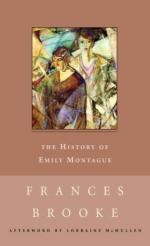|
This section contains 7,142 words (approx. 24 pages at 300 words per page) |

|
SOURCE: "The Margins of Sentiment: Nature, Letter, and Law in Frances Brooke's Epistolary Novels," in Ariel, Vol. 23, No. 3, July, 1992, pp. 7-25.
In the following essay, Benedict examines Brooke's use of the epistolary novel form to challenge the prevailing sentimental ideology of that genre.
The most popular form of literary sentimentalism in the eighteenth century was the epistolary novel.1 The epistolary method aims to present human nature released from social convention, meditating on the faculty which sentimentalists saw as the spring of virtue: feeling. Through intimate letters describing characters' responses to emotions and events, these novels show sentiment even as it is being experienced, both to stir the reader's moral response and to demonstrate the sentimental thesis that moral virtue is natural instinct, not learned behaviour.2 In these novels, romantic love most often provides the plot to prove this thesis. The popular sentimental novelist Frances Brooke, however, challenges the...
|
This section contains 7,142 words (approx. 24 pages at 300 words per page) |

|


